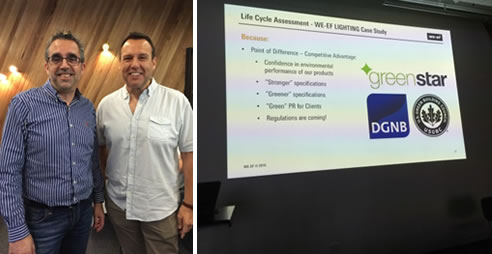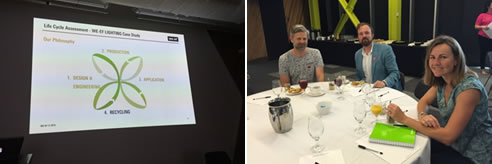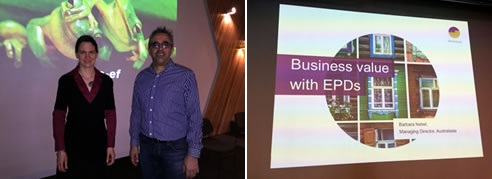At the recent Festival of Landscape Architecture: This Public Life, held in Melbourne, WE-EF took centre stage in presenting an industry breakfast designed to deepen industry understanding of Environmental Product Declarations (EPD). EPDs are quickly becoming the industry-standard for business-to-business communication of environmental data in the construction industry and in green / sustainable public procurement. They provide decision makers with an immediate, credible and non-judgmental way to assess a product's environmental impacts over its full life cycle.
In order to understand the benefits of EPDs, it's important to understand the green building market and the opportunities therein. All major green building schemes - LEED, GreenStar, DGNB, BREEAM - have implemented systems for disclosing environmental information for building products and award points based on EPDs.
The demand for green buildings is growing, especially in densely populated areas both in leading markets like the United States and also in Australia.
"But just painting it green doesn't help, so we really need credible facts and figures," said keynote speaker at this breakfast session, Dr Barbara Nebel from thinkstep.
The founder and current president of the Life Cycle Association New Zealand said the built environment causes considerable impact in regard to carbon emissions, water consumption etc. "That is why it's essential to focus on products and materials, especially when you think about how many more buildings we'll need to build over the next few years".
"In the past the clear focus was on operation or maintenance but with buildings becoming more and more energy efficient, a lot of impact goes back to the products and materials used in a building," said Dr. Nebel.

"So the focus has moved from energy consumption to the actual substance of a building. That's why it is so important to look at what materials are made of. Is there a lot of recycled material in there? How far have these things been transported? How much energy was used to manufacture the material?"
A product EPD reports those embodied environmental impacts for example on energy, resources, carbon emissions or other emissions to the atmosphere and water.
Growing demand for EPDs
Sustainability in every aspect of a building's design, construction and operation is currently expanding worldwide. In the UK, Brighton & Hove City Council is the first council in the UK to require an embodied carbon assessment of developments as part of its planning permission process.
In France, EPDs will be required for all public domain tenders as of 2017. Closer to home, Lend Lease asks in its supplier questionnaire: "Has your Company carried out any Life Cycle Analysis on your product(s) and made this information available through Environmental Product Declarations (EPDs) or other methods - What percentage of your products have an EPD?"
"GreenStar gives points for projects that have used EPDs but they also give credits for life cycle assessment studies done on full buildings," said Dr. Nebel, adding that there is an increasing demand for EPDs in Australia. Environmental conscious architects, engineers and developers cannot effectively lower the carbon emissions of buildings, unless they have a true understanding on what those impacts are. EPDs provide this insight.
Content of an EPD
Even if there is a growing demand for EPDs, many manufacturers are still reluctant to go down that path. One of the main reasons is the perceived risk of sharing too much detailed and confidential information. "EPDs are not about sharing commercially sensitive data," said Barbara, "they are just about disclosing environmental information for accurate and fair assessments".
How do other sectors balance the need for confidentiality with provision of consumer information?
Clearly, food labelling provides nutritional information in a similar way for all food products, but it doesn't go into detail about how they make the products, says Dr. Nebel. The information presented in a standardized format is neutral; so that consumers can compare one product to another across multiple criteria, e.g. sodium, calories, fat etc.
Credibility
An EPD summarizes the results of a full Life Cycle Assessment (LCA) based on internationally agreed standards. Before an EPD can be published, it must be verified by an independent organization and be registered with a recognized EPD Programme.
The business case for EPDs
The benefits of LCA studies go beyond the publication of EPDs. When going through the process of doing an LCA the manufacturer may also gain valuable insights into 'hot spots' where the product can be improved and where cost savings can be identified.
Dr. Nebel said companies such as a well-known commercial floor covering manufacturer, have exploited the benefits of LCAs and published EPDs of over 90% of their products.
"By doing LCA studies, they've identified a fourfold reduction in the carbon footprint of their product that they could achieve," she said.
"They also identified some hotspots and realized that they need to manufacture things differently... they came up with a whole new product just because they wanted to reduce environmental impact." This product now represents a significant percentage of the company's overall sales.
"So it is an opportunity to identify new markets as well," said Dr. Nebel.
Also on hand at the breakfast session was managing director of WE-EF Lighting, Ian Cerfontyne. He explained the reasons why WE-EF was the first company to conduct LCA in the exterior lighting industry.
"WE-EF's success has been built around a simple philosophy, longevity. WE-EF uses LCA and EPDs to quantify, document and communicate the environmental impacts of their products. This is key to our belief that initial cost is only a single element that should be considered in product selection, energy use and therefore lifetime cost and impact on the planet must be part of the decision-making criteria".
WE-EF offers 15 EPDs and LCA Tools for Environmental Project Assessment, along with analysis of proposed projects, including the ability to compare different options, as examples of the environmental gains possible.
It was one of the first companies to use EPDs to provide detailed documentation in line with the application of ISO 14025 and EN 15804 standards to the ecological footprint of its outdoor luminaires, across all phases of their life cycles.
"It offers us a point of difference and competitive advantage," said Cerfontyne, adding that the company is confident in the environmental performance of its products that ensure clients are ready for changes in regulations that will likely occur in the near future.








 Modern Catenary Solution Fit for
Modern Catenary Solution Fit for WE-EF's New Managing Director for
WE-EF's New Managing Director for A New Era for WE-EF LIGHTING – A Home
A New Era for WE-EF LIGHTING – A Home Myers Park Lighting Upgrade:
Myers Park Lighting Upgrade: Bridging the Past and Future: Old Murray
Bridging the Past and Future: Old Murray WE-EF Profile Projectors for Sharper
WE-EF Profile Projectors for Sharper Award-winning Bay Pavilions, Arts +
Award-winning Bay Pavilions, Arts + Enhancing Transit Experience at Byron
Enhancing Transit Experience at Byron Intelligently Illuminating the Bay Run
Intelligently Illuminating the Bay Run WE-EF Lighting's Role in Protecting
WE-EF Lighting's Role in Protecting Sustainable LED Upgrade Kit from WE-EF
Sustainable LED Upgrade Kit from WE-EF A Natural Paradise Rottnest Island by
A Natural Paradise Rottnest Island by WE-EF LIGHTING's Braeside Expansion
WE-EF LIGHTING's Braeside Expansion Street and Area Pole-Mounted Luminaires
Street and Area Pole-Mounted Luminaires Smart Lighting Control Technology from
Smart Lighting Control Technology from High-Output Floodlights with Modern LED
High-Output Floodlights with Modern LED Bondi Beach Pavilion Reimagined by WE-EF
Bondi Beach Pavilion Reimagined by WE-EF Balancing Needs: Sea Turtle Conservation
Balancing Needs: Sea Turtle Conservation Architecturally Pleasing Recessed
Architecturally Pleasing Recessed Luminaires for Lake Macquarie Multi-Arts
Luminaires for Lake Macquarie Multi-Arts
